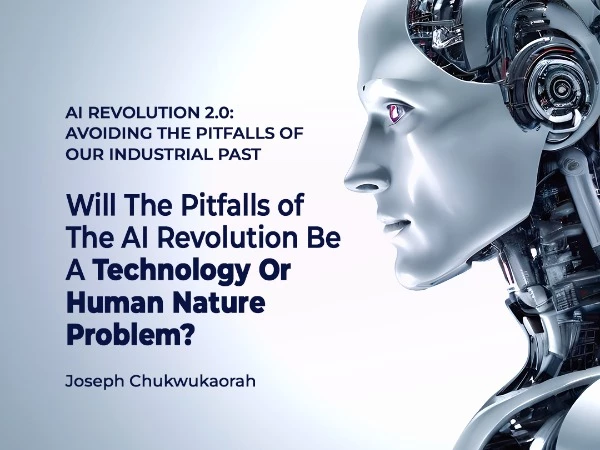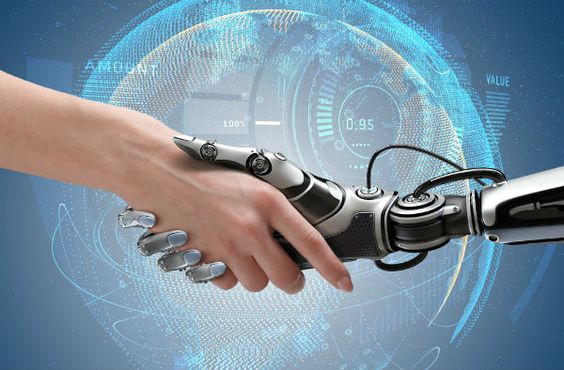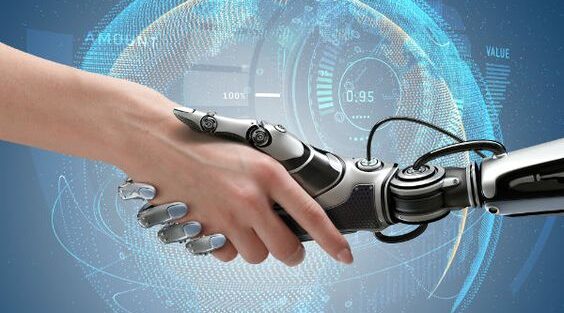
AI Revolution 2.0: Avoiding the Pitfalls of Our Industrial Past
By Joseph Chukwukaorah Tweet
The salty tang of the sea mingled with the rhythmic thump of wood against wood in the heart of Greenock shipyard. Here, Mr. Watt, a master carpenter and shipwright, built dreams – sturdy vessels and charming houses that echoed with the song of success. But beneath the booming business lived a quieter truth: worry for his young son, James.
He was a delicate boy, often plagued by sickness, migraines, and toothaches. Little did anyone suspect that this unassuming child would one day become the renowned inventor who transformed the clunky steam engine into a powerful engine for industry, forever changing the course of history.
Imagine a world where farmers toiled by hand, cities were small and quiet, and most goods were crafted one by one. Then, boom! The Industrial Revolution roared in, slamming the brakes on that slow-paced life. Machines powered by steam muscled their way into factories, churning out goods at lightning speed. This wasn’t just a change, it was a whole new ball game. Cities swelled, economies boomed, and a brand-new social order emerged – all thanks to the clang and clatter of industry.
While the Industrial Revolution left scars on society and the environment, its infrastructure and technological leaps laid the groundwork for our interconnected, information-driven world. This happened thanks to mass production, efficient transportation, and early communication technologies. These advancements allowed information to be gathered and shared on a massive scale. Innovations like the telegraph and telephone brought people closer, while the need for efficient data management arose with booming industries. The mid-20th century invention of the computer further propelled us into the Information Age.

The Information Age, much like the Industrial Age, is a story of progress and peril. The breakneck speed of technological innovation, particularly the rise of Artificial Intelligence, has opened exciting possibilities but also fueled mounting concerns. Issues like privacy violations, data breaches, misinformation campaigns, job displacement, and widening social gaps cast a long shadow over our digital progress. Moreover, the ever-present tether to our devices raises the specter of digital addiction and mental health struggles.
Juggling the benefits and drawbacks of information tech can be tricky. But hey, the past offers handy lessons! Fortunately, historical analysis, particularly focusing on the Industrial Revolution, offers valuable insights that can teach us how AI’s rise might impact individuals and communities. This historical wisdom also helps us set realistic expectations for AI’s potential.
Lessons for the use and adoption of AI from The Industrial Revolution
- Ethical considerations: Just like the Industrial Revolution faced backlash over harsh worker conditions, the rise of AI sparks ethical concerns about privacy, biased algorithms, and job losses. To guide AI development responsibly, ethical considerations must be front and center. This means ensuring transparency in how AI works, incorporating diverse viewpoints in its design, protecting people’s privacy, following legal and ethical frameworks, and regularly checking for potential problems. Open communication and public discussions are crucial too. By taking these steps, we can build trust, fairness, and responsible AI that benefits everyone.
- Worker displacement and retraining: Just as machines took over manual jobs during the Industrial Age, AI could automate many tasks today, leaving some people without work. To avoid this, there are things we can do. We can help workers learn new skills and adapt to changing roles. We can even redesign jobs to team up humans and AI. Encouraging entrepreneurship and innovation can create new jobs too. Plus, safety nets like unemployment benefits can ease the transition. By thinking ethically about AI, we can make sure it benefits everyone, not just replaces workers.
- Social Impact: The Industrial Age’s stark inequalities must not be our blueprint for the AI era. We can’t let AI exacerbate existing gaps, leaving marginalized communities further behind. Instead, we must design its adoption with social impact in mind, ensuring its benefits reach everyone. This requires a two-pronged approach: mitigating AI’s potential for harm and harnessing its power for good. We must actively combat bias in algorithms, bridge the digital divide, and ensure transparency in AI decision-making. Simultaneously, we can empower communities with AI-powered education, healthcare, and economic opportunities. By choosing this inclusive path, we can build an AI future where technology lifts, not excludes, shaping a more equitable and empowered society for all.
- Environmental Sustainability: While the Industrial Age left deep scars on the environment, the potential benefits of AI come with their own environmental concerns, namely its significant energy consumption and resource demands. Thankfully, there are ways to make AI usage more sustainable, minimizing its impact on our planet. Here are three key approaches:
- Power Up with Efficiency: We can reduce the carbon footprint of AI systems by crafting “green” algorithms that use less energy and tapping into renewable sources like solar or wind power.
- Cool Down Data Centers: Efficient cooling systems and decentralizing computing power can dramatically lower the energy needs of the massive data centers that fuel AI.
- Mindful Hardware: From responsible electronics disposal to eco-friendly hardware design, considering the entire lifecycle of AI equipment minimizes e-waste and protects our planet for the future.
5. Transparency and accountability: Just as power during the Industrial Revolution concentrated in the hands of a few, concerns now arise about who controls the powerful algorithms in our AI-driven world. This is where transparency becomes crucial. Imagine being able to see how an AI model makes decisions, like peeking under the hood of a car engine. That’s transparency in action. It builds trust, allows us to hold developers accountable, and ensures AI is used responsibly. The EU AI Act recognizes this by emphasizing transparency as a key principle. But even with regulations like this, we can’t simply rely on laws. We, as a society, must actively hold ourselves accountable for ensuring responsible AI development and deployment.
As the epochs of human history unfold, our fundamental human nature remains constant, serving as a pivotal force in shaping these eras and influencing their impact on human existence, whether for better or for worse.
While it is acknowledged that the digital revolution can have adverse effects on humanity, it’s crucial to recognize that these impacts stem more from human nature, driven by a pursuit of selfish gains, rather than inherent flaws in the technology itself.
Learning from the Industrial Revolution allows us to approach the Age of AI with cautious optimism. By prioritizing ethics, inclusivity, and sustainability, we can harness the power of AI to create a better future for all, not just a repeat of past mistakes.




